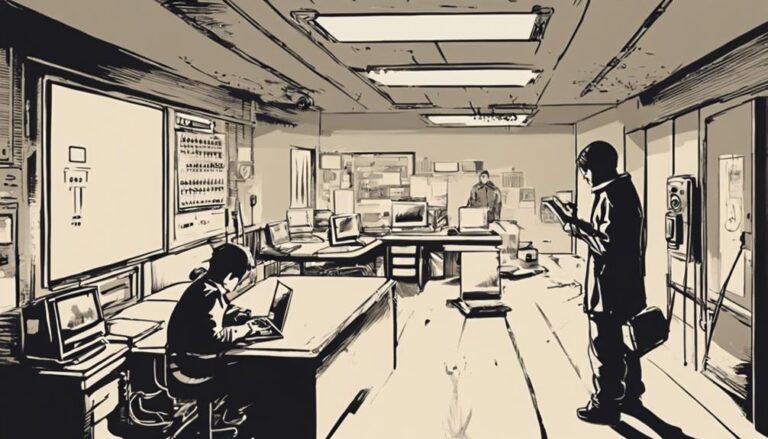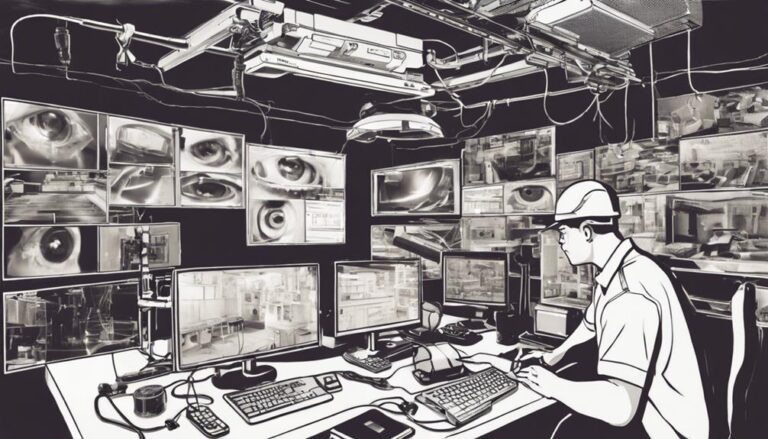When choosing between H.264 and H.265 for CCTV systems, opt for H.265 for better compression and video quality. H.265 reduces video data size by almost half without losing detail, allowing you to store more footage and cut costs. Experience clearer images and smoother streaming with reduced bandwidth usage. However, H.265 may necessitate newer devices for complete compatibility, while H.264 is widely supported but requires more storage space. Upgrading to H.265 guarantees modern and efficient surveillance. Stay informed to grasp the full benefits and considerations of each option.
Compression Efficiency
H.265’s improved compression efficiency makes it a game-changer for CCTV systems. You’re probably tired of dealing with massive storage requirements and bandwidth limitations. Well, H.265 is here to change that. It compresses video data to nearly half the size of H.264 without losing critical details. This means you can store more footage on the same hard drive and reduce your storage costs considerably.
Imagine not having to constantly upgrade your storage solutions or worry about running out of space. H.265 allows you to keep months of footage without sacrificing quality. Plus, with smaller file sizes, you’ll experience smoother streaming and faster data transfer, even on limited bandwidth. This is perfect for remote monitoring, giving you the freedom to access your CCTV feeds from anywhere without frustrating lag or buffering.
Additionally, the reduced file sizes mean you can expand your surveillance network without investing in expensive infrastructure. You can add more cameras and cover more areas, enhancing security while keeping costs down. Overall, H.265’s superior compression efficiency empowers you to maximize your surveillance capabilities and enjoy greater flexibility.
Video Quality
When it comes to video quality, you’ll notice a significant improvement with H.265 over H.264. The newer H.265 codec delivers crisper and clearer footage by enhancing the resolution and reducing noise. This means you get more detailed and vibrant images, making it easier to identify important details like faces and license plates.
H.265 utilizes advanced techniques to uphold high-quality visuals even in challenging conditions, such as low light or high motion. You’ll appreciate how this codec handles fast-moving objects without that annoying blurring effect. Whether you’re monitoring your property or keeping an eye on a bustling workplace, H.265 guarantees you don’t miss a thing.
With H.265, your CCTV system becomes a powerful tool for surveillance, giving you the freedom to monitor effectively and confidently. The improved clarity and detail help you make better decisions, enhancing your sense of security. You’re not just capturing video; you’re capturing high-quality evidence that stands up to scrutiny.
Storage Requirements
You’ll notice a substantial difference in storage requirements between H.264 and H.265 codecs. If you’re looking to maximize your storage space, H.265 is the way to go. It offers more efficient compression, reducing file sizes by nearly 50% compared to H.264. This means you can store almost double the footage on the same hard drive without sacrificing quality.
Imagine the freedom of not constantly worrying about running out of storage. With H.265, you can keep historical footage for longer periods, giving you peace of mind and the flexibility to review past events without hassle. Plus, smaller file sizes translate to less frequent need for storage upgrades, saving you both time and money.
H.265 achieves this by using more advanced algorithms and higher processing power. While this may require a bit more from your hardware initially, the long-term benefits are clear. You’ll spend less on storage solutions and have more room for high-definition recordings. If you’re serious about efficient storage and long-term cost savings, switching to H.265 is a smart move. Embrace the freedom of optimized storage without compromising on the quality of your CCTV footage.
Bandwidth Consumption
Many find that H.265 greatly reduces bandwidth consumption compared to H.264. When you’re setting up a CCTV system, you’ll want to make sure that your network runs smoothly without unnecessary congestion. H.265, also known as High Efficiency Video Coding (HEVC), can help achieve this because it compresses video more efficiently than H.264. This means you can transmit higher quality video without taking up as much bandwidth. Here are three main reasons why H.265 is the better choice for reducing bandwidth consumption:
- Enhanced Compression: H.265 uses advanced algorithms to compress video data more effectively, which can reduce bandwidth usage by up to 50% compared to H.264.
- Higher Quality at Lower Bitrates: You can maintain or even improve video quality while using lower bitrates. This means smoother streaming and less data strain on your network.
- Future-Proofing: Investing in H.265 technology now ensures your system can handle higher resolutions and more data-intensive applications down the road.
Compatibility
Compatibility between H.264 and H.265 can be a major concern when upgrading or integrating new CCTV systems. You might find that older systems mainly support H.264, making it tricky to mix and match with newer H.265 technology. The key is to make sure that your equipment, from cameras to recorders, can handle both codecs smoothly.
Here’s a quick comparison to help you out:
| Feature | H.264 Compatibility | H.265 Compatibility |
|---|---|---|
| Older Devices | Widely Supported | Limited Support |
| Newer Devices | Generally Supported | Widely Supported |
| Storage Solutions | Compatible | Needs Modern Systems |
| Software Players | Broad Compatibility | Selective Compatibility |
If you’re using older NVRs (Network Video Recorders) or software, you might need to upgrade to make sure of full compatibility with H.265. Many modern systems and software solutions now support both H.264 and H.265, but it’s always good to double-check before making any purchases.
Don’t let compatibility issues hold you back. By understanding these differences and planning your upgrades accordingly, you can enjoy the benefits of H.265’s improved efficiency without running into unexpected roadblocks. Embrace the freedom of a smooth shift and a more efficient CCTV system.
Cost Implications
Upgrading to H.265 can initially seem costly, but the long-term savings in storage and bandwidth make it a worthwhile investment. With H.265, you’ll find that the benefits far outweigh the initial expenses. Here’s why:
- Reduced Storage Costs: H.265 uses advanced compression techniques which reduce the file size by up to 50% compared to H.264. This means you’ll need less storage space, cutting down on expensive hard drives or cloud storage solutions.
- Lower Bandwidth Requirements: H.265’s efficient compression also means it requires less bandwidth for video transmission. This can notably reduce your monthly internet costs, especially if you’re using multiple cameras or high-resolution footage.
- Fewer Hardware Upgrades: While you might need to invest in new H.265-compatible devices, the reduced load on your network and storage systems means you won’t need frequent hardware upgrades. This can save you money on server upgrades and maintenance.
Future-Proofing
Looking ahead, adopting H.265 technology guarantees that your CCTV system remains efficient and relevant for years to come. Embracing H.265 means you’re prepared for the high-resolution future without worrying about massive storage requirements. This codec compresses video data more efficiently than H.264, cutting down on bandwidth and storage needs while maintaining superior image quality.
With H.265, you won’t be tied down by outdated tech. The world of surveillance is rapidly evolving, and being stuck with H.264 could limit your system’s capabilities. H.265 is designed to handle 4K video and beyond, preparing you for any future upgrades. This forward-thinking approach ensures that you won’t need a complete system overhaul anytime soon.
Moreover, H.265’s efficiency extends the lifespan of your storage devices, saving you money and hassle in the long run. You’ll enjoy better performance and lower costs over time. By choosing H.265, you’re investing in a technology that adapts to advancements, giving you the freedom to focus on what matters most—protecting your assets without compromise.
Make the smart move now, and make sure your CCTV system is ready for whatever the future holds.
Frequently Asked Questions
How Does H 265 Affect the Frame Rate of Recorded CCTV Footage?
When you use H.265, you’ll notice it doesn’t notably impact the frame rate of your CCTV footage. It compresses data more efficiently, so you get higher quality video without sacrificing the frame rate.
Are There Specific Hardware Requirements for H 265 CCTV Systems?
Think of H 265 as a high-performance sports car—it needs a robust engine. You’ll need compatible cameras, NVRs, and possibly upgraded storage to handle the efficiency and compression power that H 265 offers.
Can H 265 Be Used for Remote Viewing on Mobile Devices?
Yes, you can use H.265 for remote viewing on mobile devices. It’s efficient and saves bandwidth, giving you more freedom to monitor your CCTV footage from anywhere without worrying about data limits.
How Do H 264 and H 265 Impact Video Playback Speed?
You’re wondering how H.264 and H.265 impact video playback speed. H.265 offers better compression, so you’ll experience smoother playback with less buffering. H.264 is older, and might cause slower playback and more data usage.
What Are the Typical Installation Challenges for H 265 CCTV Systems?
Ever felt restricted by tech issues? You might face compatibility problems with older hardware, require more processing power, and need greater storage capacity. But overcoming these challenges can lead to higher efficiency and better video quality.



